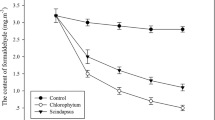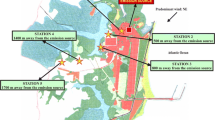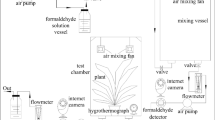Abstract
The effect of SO2 on the photosynthesis ofClethra barbinervis collected from a smoke-polluted area near the Ashio copper smelter in Tochigi Prefecture was compared withC. barbinervis collected from a nonpolluted district in Tsukuba, Ibaraki Prefecture andQuercus mongolica var.grosseserrata grown in a nonpolluted field in Nagano Prefecture. The plants were exposed to 0.5–1.5 p.p.m. SO2 for 90 min (short-term) and to 0.3 p.p.m. SO2 for 31–39 days (long-term). TheClethra plants from both sites had a lower intrinsic stomatal conductance and photosynthetic rate thanQuercus plants. Short-and long-term fumigation caused stomatal closure inQuercus plants, but had little effect on the stomatal conductance ofClethra plants. Under short-term fumigation, nonstomatal photosynthetic inhibition per unit of absorbed SO2 was smallest inClethra plants from Ashio. Long-term fumigation caused photosynthetic decline and visible foliar injury toQuercus plants, but had no effect onClethra plants from Ashio. Consequently,Clethra plants from Ashio had a higher photosynthetic rate thanQuercus plants after long-term fumigation. These results suggest thatC. barbinervis populations in the smoke-polluted area of Ashio had evolved high SO2 resistance connected with SO2 detoxification ability in mesophyll cells.
Similar content being viewed by others
References
Ayazloo M. &Bell J. N. B. (1981) Studies on the tolerance to SO2 of grass populations in polluted areas. I. Identification of tolerant populations.New Phytol. 88: 203–22.
Ayazloo M., Garsed S. G. &Bell J. N. B. (1982) Studies on the tolerance to SO2 of grass populations in polluted areas. II. Morphological and physiological investigations.New Phytol. 90: 109–26.
Bell J. N. B. &Clough W. S. (1973) Depression of yield in ryegrass exposed to sulfur dioxide.Nature 241: 47–9.
Bell, J. N. B. &Mudd C. H. (1976) Sulfur dioxide resistance in plants: A case study ofLolium perenne. In:Effects of Air Pollutants on Plants (ed. T. A. Mansfield) pp. 87–103. Cambridge University Press, London.
Bradshaw A. D. &McNeilly T. (1981)Evolution and Pollution. Edward Arnold, London.
Freedman B. &Hutchinson T. C. (1980) Long-term effects of smelter pollution at Sudbury, Ontario, on forest community composition.Can. J. Bot. 58: 2123–40.
Horikawa Y. (1972)Atlas of the Japanese Flora: An Introduction to Plant Sociology of East Asia. Gakken, Tokyo.
Horsman D. A., Roberts T. M. &Bradshaw A. D. (1978) Evolution of sulfur dioxide tolerance in perennial ryegrass.Nature 276: 493–4.
Horsman, D. A., Roberts T. M. &Bradshaw A. D. (1979) Studies on the effect of sulphur dioxide on perennial ryegrass (Lolium perenne L.). II. Evolution of sulphur dioxide tolerance.J. Exp. Bot. 30: 495–501.
Japan Environmental Agency (1990)Air Pollution in Japan. Gyousei, Tokyo (in Japanese).
Miller P. R. &McBride J. R. (1975) Effects of air pollutants on forests. In:Responses of Plants to Air Pollution (ed. J. B. Mudd & T. T. Kozlowsky) pp. 195–235. Academic Press, New York.
Miyawaki A., Ohba T. &Murase N. (1969)Scientific Studies on Mt Hakone and the Manazuru Peninsula. Kanagawa Pref. Board of Education of Kanagawa Pref. Yokohama (in Japanese).
Natori T. &Totsuka T. (1984) An evaluation of high resistance inPolygonum cuspidatum to sulfur dioxide (SO2).Jpn. J. Ecol. 34: 153–9.
Ohwi J. &Kitagawa M. (1983)New Flora of Japan. Shibundo, Tokyo (in Japanese).
Saito K., Kawai Y. &Abe H. (1976) Ecological studies on the solfatara vegetation in Mt Zao, northeast Japan.Bull. Yamagata Univ. Nat. Sci. 9: 91–111 (in Japanese with English summary).
Smith W. H. (1981)Air Pollution and Forests: Interactions between Air Contaminants and Forest Ecosystems. Springer-Verlag, New York.
Suzuki H. (1967) Basic studies on afforestation for the rehabitation of bare land devastated by refinery smoke from the Ashio Copper Mine. Report I.Bull. College Agric. Utsunomiya Univ. 6: 25–76 (in Japanese with English summary).
Suzuki S. (1986) Sommergrüne Niederwälder. In:Vegetation of Japan: Kanto (ed. A. Miyawaki) pp. 338–53. Shibundo, Tokyo (in Japanese).
Taylor G. E. Jr (1978a) Plant and leaf resistance to gaseous air pollution stress.New Phytol. 80: 523–34.
Taylor G. E. Jr (1978b) Genetic analysis of ecotypic differentiation of an annual plant species,Geranium carolinianum L., in response to sulfur dioxide.Bot. Gaz. 139: 362–8.
Taylor G. E. Jr &Murdy W. H. (1975) Population differentiation of annual plant species,Geranium carolinianum L., in response to sulfur dioxide.Bot. Gaz. 136: 212–15.
Tochigi Prefectural Research Institute For Environmental Pollution (1975)Annual Report of the Tochigi Pref. Research Institute for Environmental Pollution 1: 78–83 (in Japanese).
Usui H., Arihara T. &Shimada R. (1975) Soil contamination and specialized vegetation in Ashio copper mine district.Bull. College Agric. Utsunomiya Univ. 9: 25–35.
Wagner W. L., Martin W. C. &Aldon E. F. (1978) Natural succession on strip-mined lands in northwestern New Mexico.Reclamation Review 1: 67–73.
Winner W. E. &Bewley J. D. (1978) Contrasts between bryophyte and vascular plant synecological responses in an SO2-stressed white spruce association in central Alberta.Oecologia 33: 311–25.
Winner W. E. &Mooney H. A. (1980a) Ecology of SO2 resistance. I. Effects of fumigations on gas exchange of deciduous and evergreen shrubs.Oecologia 44: 290–5.
Winner W. E. &Mooney H. A. (1980b) Ecology of SO2 resistance. II. Photosynthetic change of shrubs in relation to SO2 absorption and stomatal behavior.Oecologia 44: 296–302.
Winner W. E. &Mooney H. A. (1980c) Responses of Hawaiian plants to volcanic sulfur dioxide: Stomatal behavior and foliar injury.Science 210: 789–90
Wood L. W. Jr &Nash T. N. III. (1976) Copper smelter effluent effects of Sonoran desert vegetation.Ecology 57: 1311–16.
Yoshioka K. (1975) Volcanic vegetation: Studies on conservation of natural terrestrial ecosystems in Japan.JIBP Synthesis 8: 92–5.
Author information
Authors and Affiliations
About this article
Cite this article
Ikeda, H., Natori, T., Totsuka, T. et al. High SO2 resistance ofClethra barbinervis established in a smoke-polluted area of Ashio, Tochigi Prefecture, Japan. Ecol. Res. 7, 363–370 (1992). https://doi.org/10.1007/BF02347103
Accepted:
Issue Date:
DOI: https://doi.org/10.1007/BF02347103




